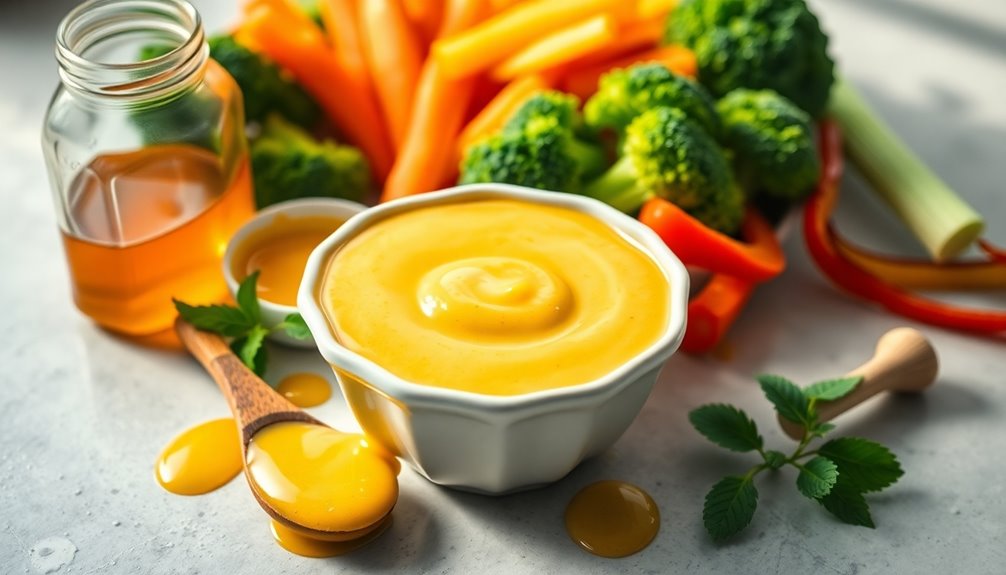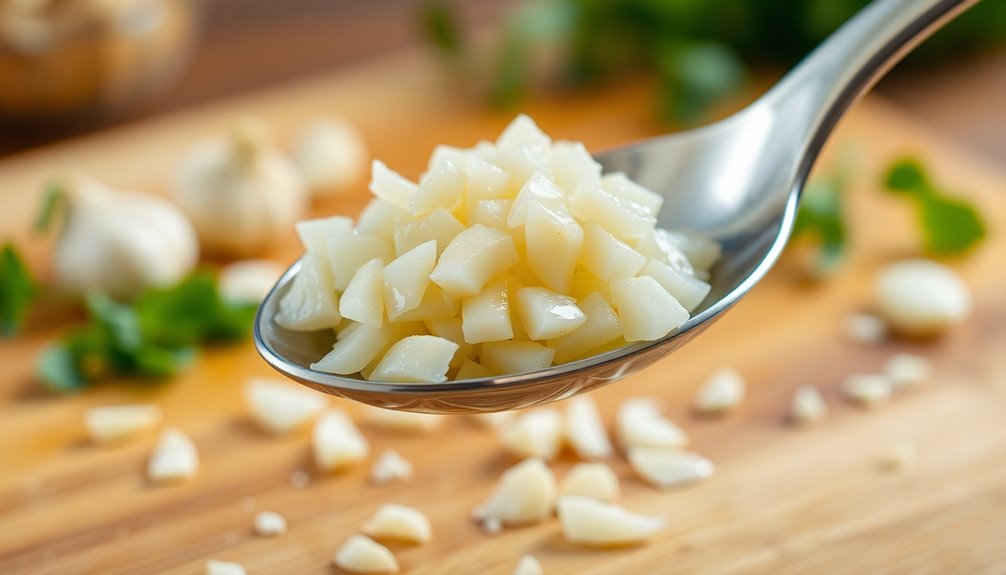You can easily whip up a tasty honey mustard sauce at home using just a few ingredients. Start by mixing equal parts of high-quality Dijon mustard and pure honey until smooth. If you want it sweeter, add honey gradually and taste as you go. For an extra kick, stir in a bit of apple cider vinegar, and season with salt and pepper. Store your homemade sauce in an airtight container in the fridge for up to two weeks. It's perfect for fresh veggies or grilled meats. Stick around to explore more tips and serving ideas that elevate your honey mustard experience!
Key Takeaways
- Blend equal parts Dijon mustard and pure honey until smooth and creamy for a basic honey mustard recipe.
- Add apple cider vinegar, olive oil, salt, and pepper to enhance flavor and adjust to personal taste.
- Gradually increase honey for sweetness, tasting after each addition to achieve the desired balance.
- Store the honey mustard in an airtight container in the refrigerator for up to two weeks.
- Serve with fresh vegetables like carrots and bell peppers for a delicious and healthy snack option.
History
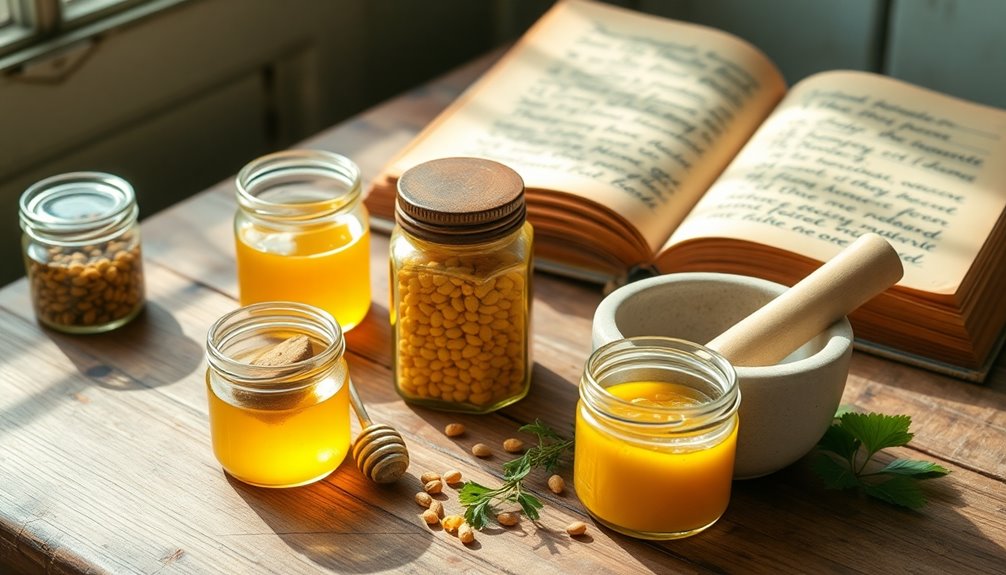
Honey mustard has a rich history that dates back centuries, as it combines two beloved ingredients: honey and mustard.
You'll find that ancient civilizations, like the Egyptians and Romans, used these ingredients for both culinary and medicinal purposes. Honey was valued for its sweetness and health benefits, while mustard seeds were prized for their tangy flavor.
The delightful blend of the two likely originated in Europe, gaining popularity during the Middle Ages when honey was commonly used as a sweetener.
By the 18th century, honey mustard became a staple condiment in many households, enhancing meats and salads alike.
Today, you can enjoy this versatile sauce in various dishes, celebrating its long-standing tradition while adding your unique twist.
Recipe
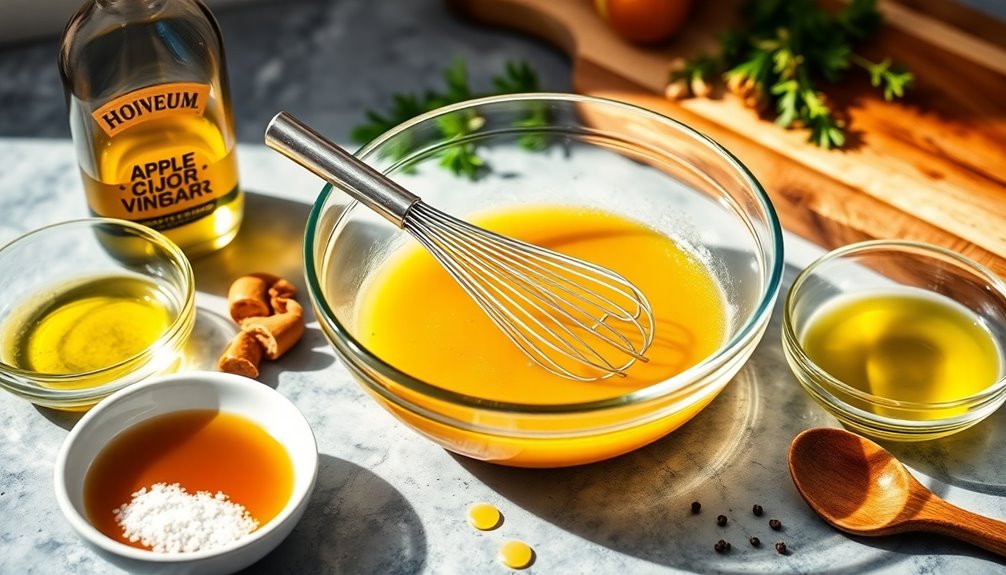
Honey mustard is a delightful condiment that marries the sweetness of honey with the tanginess of mustard, making it perfect for dipping or drizzling.
Whether you're looking to elevate a salad, enhance grilled meats, or simply enjoy it with fresh vegetables, this honey mustard recipe is simple to prepare and incredibly versatile. With just a handful of ingredients, you can whip up this delicious dressing in no time.
This homemade honey mustard not only tastes better than store-bought versions, but it's also free from preservatives and additives. You can easily adjust the balance of honey and mustard to suit your taste, making it as sweet or spicy as you like.
Plus, it can be stored in the refrigerator, allowing you to have this tasty condiment on hand whenever you need it.
Ingredients:
- 1/2 cup honey
- 1/4 cup Dijon mustard
- 1 tablespoon apple cider vinegar
- 1 tablespoon olive oil
- Salt and pepper to taste
To prepare your honey mustard, simply combine the honey, Dijon mustard, apple cider vinegar, and olive oil in a mixing bowl.
Whisk the ingredients together until they're well blended and smooth. Taste the mixture and add salt and pepper as needed.
Once ready, transfer the honey mustard to a clean jar or airtight container and refrigerate for at least 30 minutes to allow the flavors to meld.
When making honey mustard, feel free to experiment with different types of mustard or sweeteners.
For a spicier kick, try using whole grain mustard or adding a pinch of cayenne pepper. Additionally, if you prefer a thicker consistency, you can reduce the amount of olive oil or add a bit of Greek yogurt for creaminess.
Store the honey mustard in the refrigerator for up to two weeks, and always give it a good stir before using, as the ingredients may separate over time.
Enjoy your homemade honey mustard!
Cooking Steps
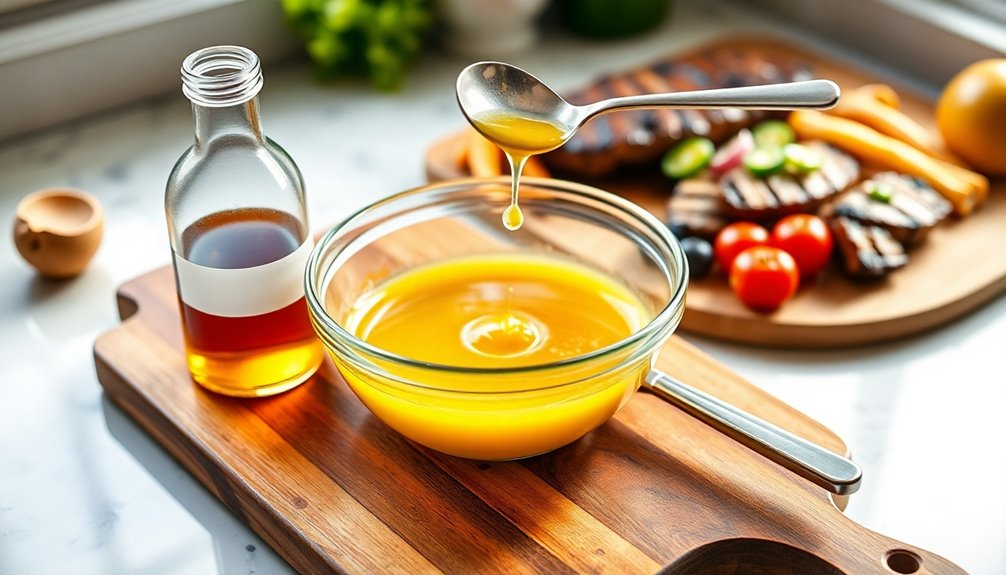
To make your honey mustard, start by gathering all your ingredients and utensils.
Then, mix the mustard and honey together, adjusting the sweetness to your taste.
Once it's ready, store it in an airtight container and serve it with fresh vegetables for a delicious treat!
Step 1. Gather Ingredients and Utensils
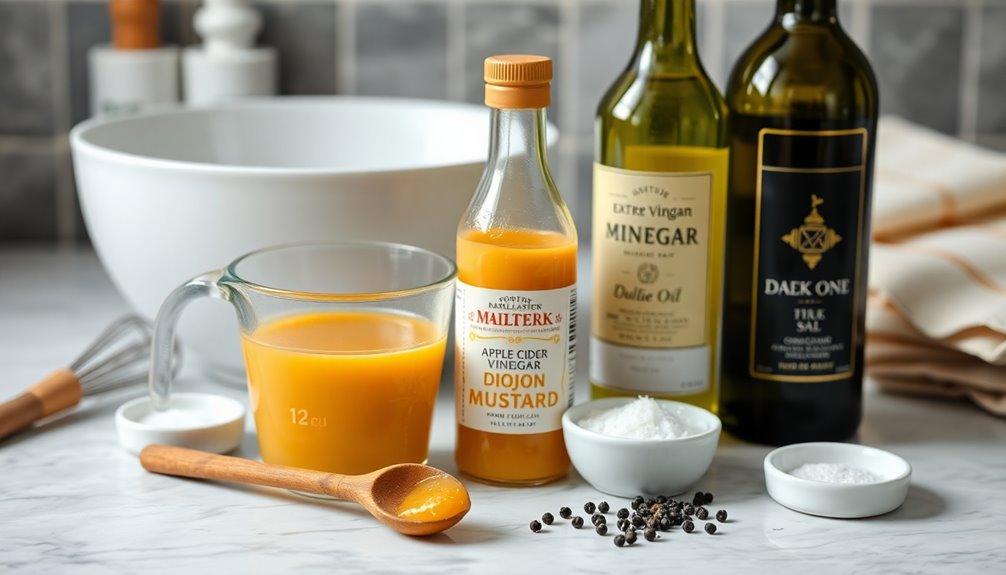
Before you start whipping up your delicious honey mustard, it's vital to gather all the necessary ingredients and utensils.
First, you'll need high-quality Dijon mustard and pure honey for that perfect balance of flavors. Don't forget to grab apple cider vinegar to add a tangy kick, along with salt and pepper for seasoning.
For utensils, a mixing bowl and a whisk are essential for combining your ingredients smoothly. You might also want a measuring spoon to guarantee accuracy in your quantities.
If you prefer a smoother texture, consider having a blender handy. Once you've collected everything, you'll be ready to plunge into creating your tasty honey mustard.
Happy cooking!
Step 2. Mix Mustard and Honey

Start by combining equal parts of Dijon mustard and pure honey in your mixing bowl.
Use a whisk or a fork to mix them together until you achieve a smooth and creamy consistency. Make certain there are no lumps, as you want a uniform texture.
If you're using a larger batch, a hand mixer can speed up the process. As you mix, feel free to adjust the ratio slightly based on your preference for tanginess or sweetness.
Once everything's blended, scrape down the sides of the bowl to guarantee all ingredients are incorporated.
This basic mix serves as a fantastic dipping sauce or salad dressing. Enjoy the delicious combination of savory and sweet flavors you've created!
Step 3. Adjust for Sweetness
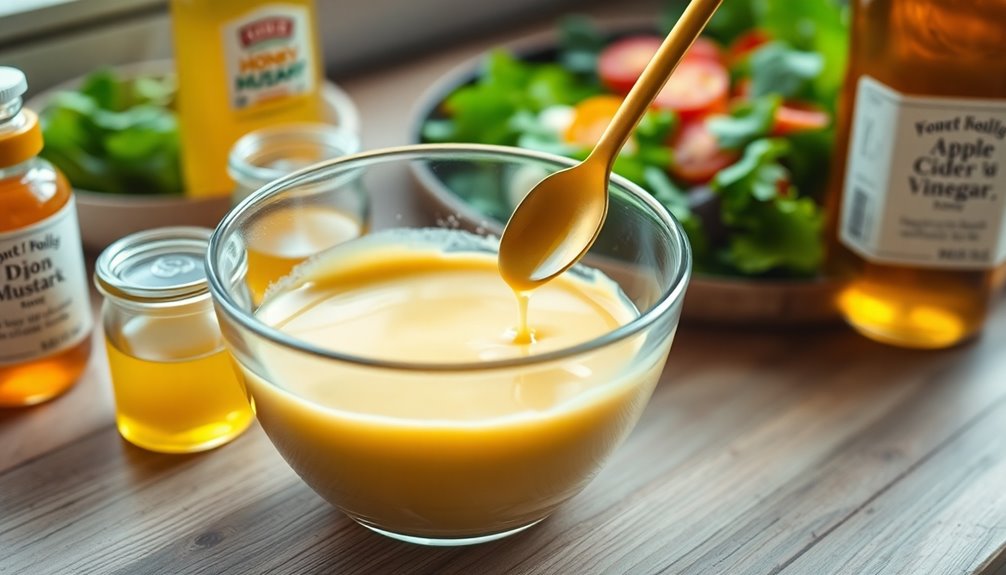
Adjusting the sweetness of your honey mustard can elevate its flavor to perfectly match your taste.
Start by tasting your mixture after combining honey and mustard. If you find it too tangy, gradually add more honey, a teaspoon at a time.
Mix well after each addition, ensuring the ingredients blend thoroughly. Remember, it's easier to add sweetness than to take it away, so go slow.
If you prefer a spicier kick, try adding a splash of apple cider vinegar or a pinch of cayenne pepper to balance the sweetness.
Keep tasting until you hit that sweet spot that satisfies your palate. This personalized touch will make your honey mustard stand out in any dish!
Step 4. Store in an Airtight Container
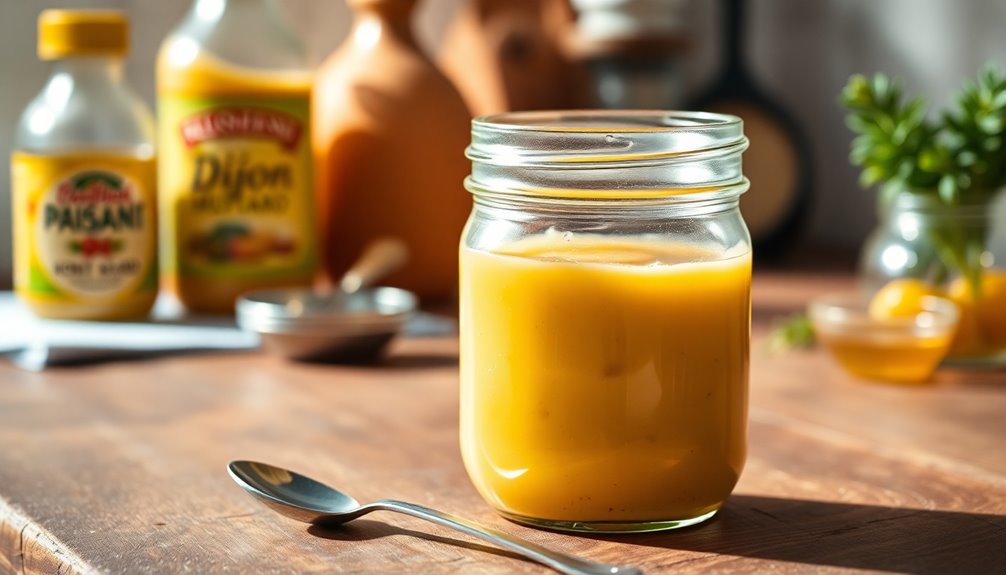
Once you've perfected the sweetness of your honey mustard, it's important to store it properly to maintain its flavor and freshness.
Start by selecting an airtight container, like a glass jar or a plastic squeeze bottle. Make sure it's clean and dry before transferring your honey mustard. Spoon the mixture into the container, leaving a little space at the top to allow for expansion.
Seal the container tightly to prevent air from getting in, which can alter the taste. Store your honey mustard in the refrigerator to keep it fresh for up to two weeks.
Remember to label the container with the date you made it, so you'll know when it's time to whip up a fresh batch!
Step 5. Serve With Fresh Vegetables

When you're ready to enjoy your homemade honey mustard, serving it with fresh vegetables is a fantastic option.
You can create a vibrant platter with crisp carrots, bell peppers, celery, and cherry tomatoes. These colorful veggies not only look great but also provide a satisfying crunch that pairs perfectly with the creamy tang of the honey mustard.
Simply wash and cut the vegetables into bite-sized pieces, arranging them on a serving tray. Then, place your honey mustard in a small bowl at the center for easy dipping.
This makes for a delicious, healthy snack or appetizer that everyone will love. Whether it's for a party or a casual gathering, fresh veggies and honey mustard are sure to impress!
Final Thoughts
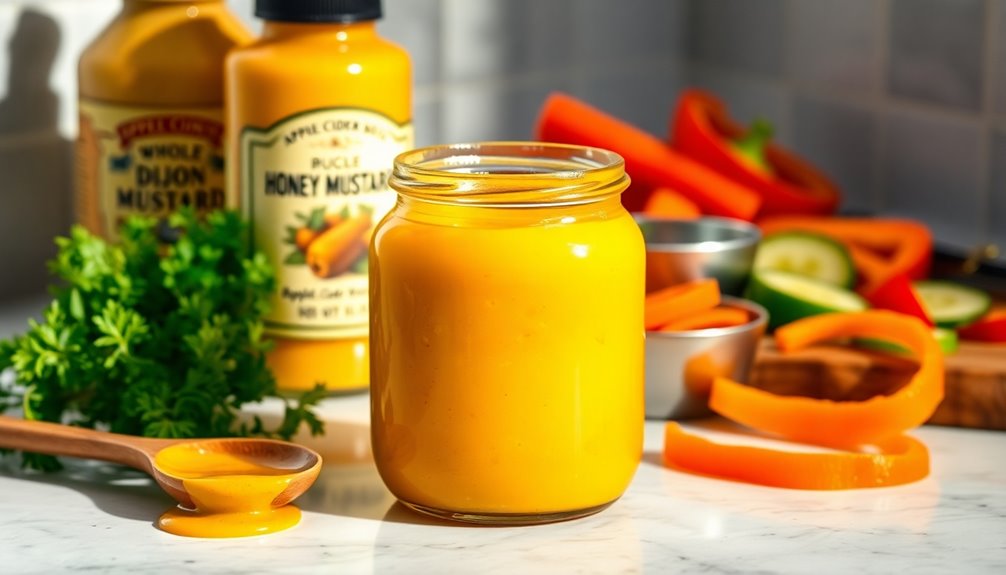
As you experiment with your homemade honey mustard, remember that the balance of flavors is key to achieving the perfect dip or dressing.
Taste as you go, adjusting the sweetness or tanginess to suit your palate. Don't hesitate to try different mustards or add spices to create a unique twist.
This recipe is versatile, so feel free to pair it with various dishes or serve it as a simple snack.
Store any leftovers in an airtight container in the fridge; the flavors will deepen over time.
Most importantly, have fun with it! Cooking is all about creativity, so let your taste buds guide you to delicious discoveries.
Enjoy your delightful honey mustard, and share it with family and friends!
Frequently Asked Questions
Can I Use Different Types of Mustard for This Recipe?
Absolutely, you can use different types of mustard for your recipe! Each type brings its own unique flavor, so feel free to experiment.
If you prefer something spicier, go for Dijon. For a milder taste, yellow mustard works well. You could even try whole grain for added texture.
Just remember to adjust the proportions to achieve the flavor balance you like. Have fun with it and discover your favorite combination!
How Long Does Homemade Honey Mustard Last in the Fridge?
Homemade sauces can be a great addition to your meals, and knowing how long they last is key.
If you've made honey mustard, it typically lasts about one to two weeks in the fridge. Just make sure to store it in an airtight container to maintain its freshness.
Always give it a sniff or a taste before using, though; if it smells off or has changed texture, it's best to toss it.
Is Honey Mustard Gluten-Free?
Yes, honey mustard is generally gluten-free! As long as you use gluten-free ingredients, you don't have to worry.
Most honey and mustard varieties are naturally free from gluten. However, always check labels to verify there are no hidden gluten-containing additives or cross-contamination.
If you're making it at home, you can control the ingredients, guaranteeing it fits your dietary needs perfectly.
Enjoy your honey mustard worry-free!
Can I Make Honey Mustard Vegan?
Yes, you can definitely make honey mustard vegan! Instead of honey, use maple syrup or agave nectar for sweetness.
Combine this with Dijon mustard, a splash of apple cider vinegar, and a bit of plant-based yogurt for creaminess.
Adjust the flavors to your liking by adding spices or herbs.
It's simple to whip up a delicious vegan version that'll satisfy your cravings while keeping it plant-based. Enjoy your tasty creation!
What Dishes Pair Well With Honey Mustard?
When you think about dishes that pair well with honey mustard, you've got plenty of delicious options.
It works great as a dipping sauce for chicken tenders or veggies. You can also drizzle it on salads for a tasty kick or use it as a glaze for roasted meats.
It complements sandwiches beautifully, especially with turkey or ham.
Don't forget to try it in wraps for an added burst of flavor!
